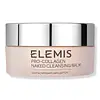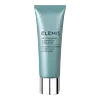What's inside
What's inside
 Key Ingredients
Key Ingredients

 Benefits
Benefits

 Concerns
Concerns

 Ingredients Side-by-side
Ingredients Side-by-side

Prunus Amygdalus Dulcis Oil
Skin ConditioningCaprylic/Capric Triglyceride
MaskingPEG-6 Caprylic/Capric Glycerides
EmulsifyingPEG-8 Beeswax
EmulsifyingCetearyl Alcohol
EmollientSorbitan Stearate
EmulsifyingSambucus Nigra Seed Oil
PEG-60 Almond Glycerides
EmulsifyingSilica
AbrasiveAvena Sativa Kernel Oil
Skin ConditioningTriticum Vulgare Germ Oil
EmollientButyrospermum Parkii Butter
Skin ConditioningCitrus Aurantium Dulcis Peel Wax
Skin ConditioningGlycerin
HumectantLecithin
EmollientBorago Officinalis Seed Oil
EmollientPhenoxyethanol
PreservativeCocos Nucifera Oil
MaskingAcacia Decurrens Flower Wax
EmollientRosa Multiflora Flower Wax
Skin ConditioningTocopherol
AntioxidantCocoyl Hydrolyzed Collagen
CleansingWater
Skin ConditioningSimmondsia Chinensis Seed Oil
EmollientPadina Pavonica Thallus Extract
Skin ConditioningPrunus Amygdalus Dulcis Oil, Caprylic/Capric Triglyceride, PEG-6 Caprylic/Capric Glycerides, PEG-8 Beeswax, Cetearyl Alcohol, Sorbitan Stearate, Sambucus Nigra Seed Oil, PEG-60 Almond Glycerides, Silica, Avena Sativa Kernel Oil, Triticum Vulgare Germ Oil, Butyrospermum Parkii Butter, Citrus Aurantium Dulcis Peel Wax, Glycerin, Lecithin, Borago Officinalis Seed Oil, Phenoxyethanol, Cocos Nucifera Oil, Acacia Decurrens Flower Wax, Rosa Multiflora Flower Wax, Tocopherol, Cocoyl Hydrolyzed Collagen, Water, Simmondsia Chinensis Seed Oil, Padina Pavonica Thallus Extract
Glycerin
HumectantCaprylic/Capric Triglyceride
MaskingPrunus Amygdalus Dulcis Oil
Skin ConditioningMicrocrystalline Cellulose
AbsorbentSambucus Nigra Oil
MaskingWater
Skin ConditioningPolyglyceryl-4 Laurate
EmulsifyingAvena Sativa Kernel Oil
Skin ConditioningTriticum Vulgare Germ Oil
EmollientPolyglyceryl-2 Stearate
EmulsifyingPolyglyceryl-6 Laurate
EmulsifyingLavandula Angustifolia Oil
MaskingGlyceryl Stearate
EmollientStearyl Alcohol
EmollientBorago Officinalis Seed Oil
EmollientLinalool
PerfumingLavandula Hybrida Oil
EmollientPelargonium Graveolens Flower Oil
MaskingEucalyptus Globulus Leaf Oil
PerfumingGeraniol
PerfumingTocopherol
AntioxidantAnthemis Nobilis Flower Oil
MaskingHippophae Rhamnoides Fruit Oil
Skin ProtectingCocoyl Hydrolyzed Collagen
CleansingCinnamomum Camphora Bark Oil
MaskingLimonene
PerfumingMentha Arvensis Leaf Oil
MaskingAcacia Decurrens Flower Wax
EmollientRosa Multiflora Flower Wax
Skin ConditioningSimmondsia Chinensis Seed Oil
EmollientCitrus Aurantium Dulcis Oil
MaskingParfum
MaskingVitis Vinifera Seed Oil
EmollientHelianthus Annuus Seed Oil
EmollientMenthol
MaskingEugenia Caryophyllus Leaf Oil
MaskingPadina Pavonica Thallus Extract
Skin ConditioningGlycerin, Caprylic/Capric Triglyceride, Prunus Amygdalus Dulcis Oil, Microcrystalline Cellulose, Sambucus Nigra Oil, Water, Polyglyceryl-4 Laurate, Avena Sativa Kernel Oil, Triticum Vulgare Germ Oil, Polyglyceryl-2 Stearate, Polyglyceryl-6 Laurate, Lavandula Angustifolia Oil, Glyceryl Stearate, Stearyl Alcohol, Borago Officinalis Seed Oil, Linalool, Lavandula Hybrida Oil, Pelargonium Graveolens Flower Oil, Eucalyptus Globulus Leaf Oil, Geraniol, Tocopherol, Anthemis Nobilis Flower Oil, Hippophae Rhamnoides Fruit Oil, Cocoyl Hydrolyzed Collagen, Cinnamomum Camphora Bark Oil, Limonene, Mentha Arvensis Leaf Oil, Acacia Decurrens Flower Wax, Rosa Multiflora Flower Wax, Simmondsia Chinensis Seed Oil, Citrus Aurantium Dulcis Oil, Parfum, Vitis Vinifera Seed Oil, Helianthus Annuus Seed Oil, Menthol, Eugenia Caryophyllus Leaf Oil, Padina Pavonica Thallus Extract
Ingredients Explained
These ingredients are found in both products.
Ingredients higher up in an ingredient list are typically present in a larger amount.
Acacia Decurrens Flower Wax isn't fungal acne safe.
Avena Sativa Kernel Oil is the oil from colloidal oatmeal.
Besides being a healthy breakfast, oats have many benefits in skincare too.
Colloidal Oatmeal helps sooth, hydrate, and protect the skin. The starches in colloidal oatmeal are able to bind water, keeping the skin hydrated.
Avena Sativa Kernel Oil is also an antioxidant. Antioxidants help stabilize free-radical molecules. These molecules may damage skin cells.
Overall,Avena Sativa Kernel Oil is great at providing the skin with moisture. It also protects the skin as an antioxidant.
Learn more about Avena Sativa Kernel OilBorago Officinalis Seed Oil is from the seeds of the starflower plant. This plant grows primarily in Europe.
This oil does not have a scent. It contains fatty acids such as linolenic acid. These fatty acids help keep skin hydrated.
Borago Officinalis Seed Oil is an antioxidant. Antioxidants help fight free-radicals. Free-radicals are molecules that may damage your skin cells.
Learn more about Borago Officinalis Seed OilThis ingredient is an emollient, solvent, and texture enhancer. It is considered a skin-softener by helping the skin prevent moisture loss.
It helps thicken a product's formula and makes it easier to spread by dissolving clumping compounds.
Caprylic Triglyceride is made by combining glycerin with coconut oil, forming a clear liquid.
While there is an assumption Caprylic Triglyceride can clog pores due to it being derived from coconut oil, there is no research supporting this.
Learn more about Caprylic/Capric TriglycerideCocoyl Hydrolyzed Collagen can help to reduce the effects of aging.
Glycerin is already naturally found in your skin. It helps moisturize and protect your skin.
A study from 2016 found glycerin to be more effective as a humectant than AHAs and hyaluronic acid.
As a humectant, it helps the skin stay hydrated by pulling moisture to your skin. The low molecular weight of glycerin allows it to pull moisture into the deeper layers of your skin.
Hydrated skin improves your skin barrier; Your skin barrier helps protect against irritants and bacteria.
Glycerin has also been found to have antimicrobial and antiviral properties. Due to these properties, glycerin is often used in wound and burn treatments.
In cosmetics, glycerin is usually derived from plants such as soybean or palm. However, it can also be sourced from animals, such as tallow or animal fat.
This ingredient is organic, colorless, odorless, and non-toxic.
Glycerin is the name for this ingredient in American English. British English uses Glycerol/Glycerine.
Learn more about GlycerinWe don't have a description for Padina Pavonica Thallus Extract yet.
Prunus Amygdalus Dulcis Oil comes from the sweet almond, a tree native to Iran. This oil has no fragrance and is non-volatile.
Almonds contain healthy fats, vitamins, and minerals. It is a rich source of Vitamin E, a great antioxidant and skin conditioning ingredient. Sweet almond oil contains fatty acids such as linolenic acid and triglycerides.
The content of sweet almond oil makes it a great emollient; it can help soften and hydrate your skin. Emollients create a barrier over your skin to trap moisture in. Sweet almond oil has antioxidant properties.
Those with an almond allergy should be careful of this ingredient and speak with a professional about using it in your skincare.
This ingredient may not be fungal-acne safe.
Learn more about Prunus Amygdalus Dulcis OilWe don't have a description for Rosa Multiflora Flower Wax yet.
This oil comes from the seeds of the desert shrub called Jojoba. It is more commonly known as jojoba oil, a non-comedogenic oil.
Jojoba oil does not contain fragrance and has many fatty-acids, making it a great soothing ingredient.
It also contains Vitamin E, a great moisturizing ingredient. Vitamin E is also an antioxidant and protects your skin against oxidative damage.
This ingredient humectant properties, meaning it helps draw moisture from the air. This helps keep your skin hydrated.
While jojoba has antibacterial properties, it is only able to kill some strains of bacteria.
Studies also show it helps in wound healing. In fact, Indigenous cultures have used jojoba as a moisturizer and to help treat burns for centuries.
Fun fact: Jojoba oil similar to natural human skin sebum, so it has a great effect on dry skin. It is also promising with helping to regulate sebum production.
Due to its fatty acid content, Jojoba oil may not be fungal acne safe. We recommend speaking with a professional if you have any concerns.
Learn more about Simmondsia Chinensis Seed OilTocopherol (also known as Vitamin E) is a common antioxidant used to help protect the skin from free-radicals and strengthen the skin barrier. It's also fat soluble - this means our skin is great at absorbing it.
Vitamin E also helps keep your natural skin lipids healthy. Your lipid skin barrier naturally consists of lipids, ceramides, and fatty acids. Vitamin E offers extra protection for your skin’s lipid barrier, keeping your skin healthy and nourished.
Another benefit is a bit of UV protection. Vitamin E helps reduce the damage caused by UVB rays. (It should not replace your sunscreen). Combining it with Vitamin C can decrease sunburned cells and hyperpigmentation after UV exposure.
You might have noticed Vitamin E + C often paired together. This is because it is great at stabilizing Vitamin C. Using the two together helps increase the effectiveness of both ingredients.
There are often claims that Vitamin E can reduce/prevent scarring, but these claims haven't been confirmed by scientific research.
Learn more about TocopherolWheatgerm oil is a yellow/reddish oil derived from germs on the common wheat. It is rich in Vitamin E, an ingredient with many skin benefits.
About 80% of the oil is made up of fatty acids. The majority of these include linoleic acid and linolenic acid.
Studies show this oil can aid in wound healing and soothing inflammation.
This ingredient may not be acne or fungal-acne safe.
Sometimes, the Vitamin E derived from wheat germ can contain gluten. However, most plant derived oil is processed to remove all proteins.
Learn more about Triticum Vulgare Germ OilWater. It's the most common cosmetic ingredient of all. You'll usually see it at the top of ingredient lists, meaning that it makes up the largest part of the product.
So why is it so popular? Water most often acts as a solvent - this means that it helps dissolve other ingredients into the formulation.
You'll also recognize water as that liquid we all need to stay alive. If you see this, drink a glass of water. Stay hydrated!
Learn more about Water